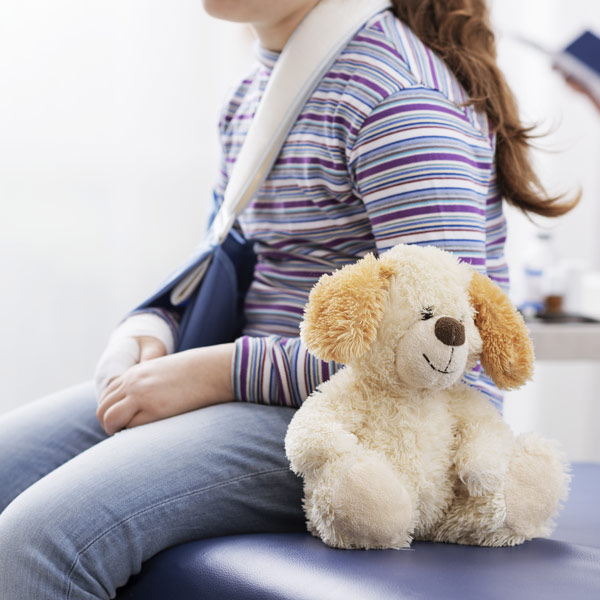Pediatric Fractures
July 2019
What You Should Know About Treating Pediatric Fractures.
Fremont Orthopaedics Staff
With summer in full swing, our doctors and staff are busy caring for patients with a variety of injuries. During the months of summer vacation, we tend to see more kiddos in our clinics with broken bones sustained during some summer fun activity.
Broken bones are also called fractures. A fracture is any complete or incomplete break in the bony structure of the skeleton. A fracture is not “a less severely broken bone”. Fractures occur in a variety of patterns depending on the cause of the injury and the health of the bone structure. Fractures are a common injury in children who are old enough to walk.
How does fracture treatment in kids vary from that of adults?
Fracture treatment in children is similar to adults in that the primary goal is to promote healing of the bone in a normal position. However, children are different than adults in that they have superior bone healing and remodeling capacity. Because of this, many pediatric bone fractures can be treated solely by external stabilization of the bone in a cast, splint, or brace. Some fractures require manipulation of the bone fragments into a more normal position before being placed in a cast or splint (this is known as “reduction”). Because of their bone healing capacities, children are less likely than adults to require an operation to stabilize the bone. However, some fractures require surgery because of their severity or location. Fractures that include a child’s growth plate are more likely to require surgical intervention and longer rehabilitation.

What can I do to treat my child’s pain?
Fractures can be quite painful, especially in the first few days after an injury. The body responds to a broken bone by producing swelling and inflammation at the site of the fracture. The most effective way to treat pain is to combat the inflammation and swelling through icing and elevation of the injured limb.
ICING: Never apply ice to bare skin. Gel ice packs or bags of crushed ice wrapped in a clean towel work well. Ice the extremity for periods of 20-30 minutes. If it is difficult to apply ice because of a bulky cast or splint, it may be helpful to apply ice up higher on the injured limb, above the cast or splint.
ELEVATION: In a reclining position, use pillows to support the limb as high as comfortable above the level of your heart. Ideally, the injured limb will rest 6-20 inches above your heart.
MEDICATION: Medication can be helpful to alleviate the discomfort associated with a fracture. Tylenol (acetaminophen) administered every 4-6 hours can be very effective for pain relief. Administer Tylenol according to the dose recommended for the child’s age and weight on the bottle. Additionally, you may also administer occasional doses of children’s ibuprofen (Motrin) to supplement the Tylenol. For questions related to pediatric pain medication, consult a pediatrician or pharmacist. Both of these medications should be stored in a secure location, out of the reach of children. Overdose of these medications is very dangerous.

How long will a fracture take to heal?
Most simple fractures will heal in 6 weeks; younger children may heal fractures even sooner. More severe fractures, especially those involving joints and growth plates, can take up to three months or more for full healing to occur. Satisfactory healing of the bone in good alignment is monitored by examinations and x-rays over several months.
What things can I do to help my child’s fracture heal?
Most children with broken bones heal remarkably well and experience minimal or no long-term effects from their fractures. The following tips may assist in bone healing and health:
ICE AND ELEVATE to limit swelling and inflammation during the first 3-7 days.
EATING A BALANCED DIET Help your child to eat a balanced and nutritious diet. Calcium and vitamin D are especially important nutrients for bone health.
STOP SMOKING/TOBACCO USE Nicotine impairs healing. Children who are exposed to secondhand smoke may be at higher risk of poorly healed fractures in growing bones.
MONITOR your child’s activity and encourage them to stick to your doctor’s recommendations for activity restrictions. Pain usually subsides long before the fracture is fully healed. Just because it doesn’t hurt doesn’t mean that they are ready for a return to full activities.
KEEP THE CAST/SPLINT DRY For more information on splint/cast care, please see a previous blog article here.
What symptoms should I seek further medical attention for?
- Your child has severe, increasing pain and swelling that is unrelieved by icing, elevation, and the medication recommended by your doctor.
- Your child has increasing tightness, numbness, tingling, or burning in the injured extremity or has difficulty moving fingers or toes below splint or cast.
- Your child has symptoms of compromised circulation to the injured extremity: fingers and toes are turning pale, purple, blue and cold to the touch.
- Your child experiences a serious fall or blow to the injured extremity and develops severe pain or reports hearing/feeling something “crack” or “move”.
- Your child develops fever or chills without other explanation, i.e. a flu or cold.
Remember...
This document contains general guidelines and is not a substitute to your physician’s instructions or an alternative to seeking appropriate medical care or follow-up appointments. For questions or concerns, seek professional medical attention. For medical emergencies, call 911.
To schedule an appointment with one of our doctors, call (307) 332-9720.


